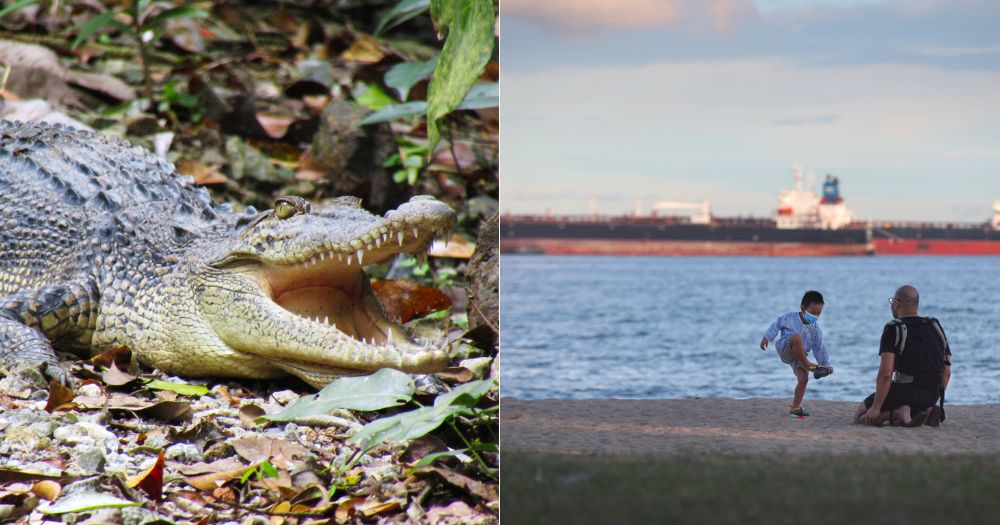COMMENTARY: "I believe that crocodiles have a place in Singapore, and I will always speak up for them and the many other species that are trying to live alongside us, but I am all too aware that many Singaporeans think coexistence is easy, but simply do not understand what it means to live with an apex predator."
Our contributor Ivan Kwan shares his close encounters with crocodiles when he was working in Sungei Buloh, before elaborating on how NParks has been working on crocodile management and what Singaporeans have to consider if we truly want to share more public spaces with crocodiles.
Ivan Kwan is a veteran nature guide and wildlife specialist in Singapore. Prior to this, he worked at Sungei Buloh Wetland Reserve for close to three years, and still actively volunteers with wildlife surveys and leads guided walks there.
Several years back, through my own actions, I could have been eaten by a crocodile.
I used to work for NParks and was based at Sungei Buloh Wetland Reserve for close to three years. While the main focus of my work involved fieldwork outside of the reserve, there were days when I was involved in some of the day-to-day operations within Sungei Buloh. This included supporting outreach activities and events on weekends, hosting guests and showing them around, staying overnight to ring shorebirds, an assortment of wildlife surveys, planting mangrove saplings, camera trapping, assisting with patrols, attending to visitors, and more. Fun times.
Sometimes we had to respond to wildlife encounters.
Wildlife in Sungei Buloh
There were times when we had to move Shore pit vipers slightly further away from the trails and boardwalks, in case somebody unknowingly got too close. Or the small family of Long-tailed macaques in the reserve would be up to some mischief, and we would have to get both the monkeys and the visitors to behave themselves.
Estuarine crocodiles were part and parcel of a typical workday at Sungei Buloh. Like other potentially dangerous wildlife such as spitting cobras and hornets, crocodiles were simply a part of the environment, but the possible consequences of a close encounter with one meant we were always on the lookout for them, especially if we were doing any sort of work in or close to the water. During our regular shorebird ringing sessions, which often involved having us standing in soft mud up to our shins at night, next to the water, someone always had to be watching out for any crocodiles lurking nearby.
For the most part, the crocodiles avoided people. Sure, we had large individuals like Tailless and Alpha, but we kept away from them, and they kept away from us. Once in a while though, a large crocodile would crawl out of the water onto a trail to bask in the sun, blocking the path. This was before the barriers were installed along the trails.
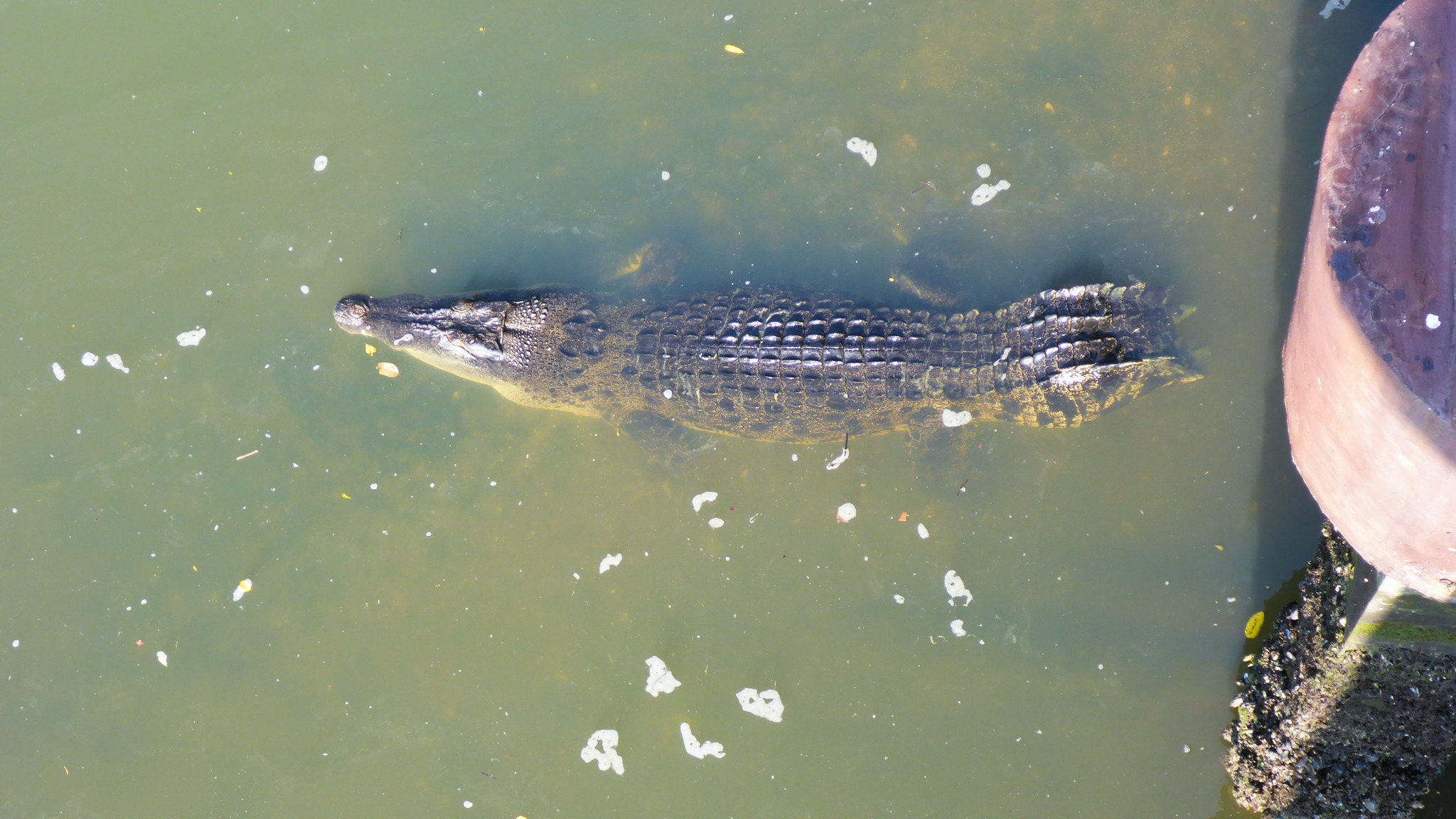 The unmistakable Tailless, one of the dominant adult male Estuarine crocodiles that reside in Sungei Buloh, seen from the old Main Bridge. Despite missing most of his tail, Tailless has not only survived, but thrived, with all the smaller crocodiles showing submission or getting out of his way. He’s also been seen mating, and on at least one occasion, tried to ambush a pair of otters as they swam up the river past him. Photo courtesy of Ivan Kwan.
The unmistakable Tailless, one of the dominant adult male Estuarine crocodiles that reside in Sungei Buloh, seen from the old Main Bridge. Despite missing most of his tail, Tailless has not only survived, but thrived, with all the smaller crocodiles showing submission or getting out of his way. He’s also been seen mating, and on at least one occasion, tried to ambush a pair of otters as they swam up the river past him. Photo courtesy of Ivan Kwan.
 Tailless, one of the large dominant males of Sungei Buloh. He is often seen from the Main Bridge, swimming up and down the river with the tides. Photo courtesy of Ivan Kwan.
Tailless, one of the large dominant males of Sungei Buloh. He is often seen from the Main Bridge, swimming up and down the river with the tides. Photo courtesy of Ivan Kwan.
While getting people to wait patiently until the reptile had enough of the attention and returned to the water was straightforward, there was always significant public concern, especially when reports of these incidents made their way to the news and social media.
Every time this happened, you’d get people saying that the crocodiles should all be culled, grumbling that the authorities would only take action after somebody was killed, and so on. Most of these comments could be dismissed and disregarded. After all, the risks were relatively low, as long as people behaved themselves and did not do stupid things.
Encounters with crocodiles
It wasn't long before I had a close encounter with a crocodile at Sungei Buloh, although I was never in any real danger.
One night, I was wading into a shallow pond to catch frogs as part of a survey, and didn’t know that the pond was occupied by a crocodile, until it suddenly burst of the water, dashed out of the pond away from me, ran through the undergrowth, and plunged into the river a short distance away. It was a small individual, about 1 to 1.5 metres long, so quite harmless compared to a large adult. I was very startled by that incident, but not shaken.
That incident, and several subsequent encounters with smaller crocodiles, where they always fled from us, made me become a little complacent. After some time, I got a bit blasé about crocodiles; sure, they were potentially dangerous, but as long as I was always on the lookout, avoided the larger ones, and didn’t take any stupid risks, I’d be fine.
 A large Estuarine crocodile keeps a low profile in the water, with only its eyes and nostrils above the surface. In murky water, it can be very easy to miss even very large crocodiles if they don’t want to be seen. Photo courtesy of Ivan Kwan.
A large Estuarine crocodile keeps a low profile in the water, with only its eyes and nostrils above the surface. In murky water, it can be very easy to miss even very large crocodiles if they don’t want to be seen. Photo courtesy of Ivan Kwan.
One day, sometime in 2015, I ended up taking a really stupid risk.
I was alone, in a staff area next to the Wetland Centre. I had some very muddy containers to wash and clean, and while I could have opted to rinse them out with a hose, I foolishly decided to stand on a boat ramp and wash them in the river. After all, the mud came from the river, might as well return the mud to the river. The tide was rising; oh good, I thought to myself at that time, I don’t have to walk too far out on the slippery, algae-covered boat ramp and get my feet wet and muddy while I wash things.
I approached the water’s edge, and took a quick glance around. All clear: no sign of any crocodiles. I squatted down, and started washing my containers. At short intervals, I would pause, look up, and scan the area, before resuming. Still no sign of crocodiles. I continued my washing.
But remember:
I was alone.
It was high tide.
I was squatting down, right at the water’s edge.
When you read about crocodile attacks, many victims were grabbed under similar circumstances, when they least expected it.
As I continued washing, I must have gotten distracted, and stopped watching my surroundings for some time. Because when I finally looked up, what I saw made me suddenly realise the terrible decision I had made, and just how vulnerable I truly was.
A large adult crocodile, some two to three metres in length, was slowly cruising past me, several metres away. It wasn’t approaching me, just silently heading upstream. I’m terrible at gauging distances, so I don’t know how far away it was. It could have been as little as 5 metres away, it could have been 10 metres, maybe a little more. Whatever the case, the moment I saw it, I immediately grabbed my containers and backed away from the water. The great reptile simply continued floating upriver, and swam out of sight.
But as I left the area, I realised one chilling fact: the moment I spotted the crocodile, it was already passing my position along the riverbank. This meant that I had been extremely careless, had kept my head down for way too long, and had failed to notice the crocodile while it was downstream and swimming closer.
Immediately after that incident, I mentioned it in passing to some of my ex-colleagues, and must have downplayed it, because at that time, I didn’t feel like I was in any real danger.
When your average workday can include an insane plethora of unpredictable potential hazards, ranging from lightning strikes, falling trees, shards of broken glass and rusty metal hidden underfoot, heatstroke, and getting stuck in soft mud as the tide rises, to beehives, venomous snakes, getting stabbed in the face by an angry heron, or simply getting lost in the forest, a near miss like that becomes just another story you laugh about at the end of just another ordinary day in the office. Besides, the crocodile was only swimming past, it's not like it lunged at me and I had to perform a split-second dodge.
But the more I thought about it, the more I realised just how close I came to possibly dying that day.
In this case, the crocodile was simply passing by, and did not take any interest in me. But what if it had been hungry? What if it had seen me, squatting down by the water’s edge, distracted, and decided to take a chance? What if the splashing and sounds made by me washing the containers had sounded like a thrashing fish, and drew its attention? Given the really small distance between us, it could have simply changed direction, silently submerged, and approached for an ambush. And I would have been none the wiser.
Why am I sharing this story?
I’m sharing this story not to make myself seem brave for surviving a potentially dangerous situation with a wild crocodile.
I was not brave. I was incredibly stupid, I was careless, I took an unbelievably unnecessary risk, and under different circumstances, I could have very well been the first documented victim of a crocodile bite in Singapore in the 21st century.
But I dare say that among all the people in Singapore who have been thinking and talking a lot about crocodiles in recent weeks, probably very few can say they've had a similar experience like mine.
The point I’m trying to make is that even among people who spend time around crocodiles on a regular basis, it's so easy to let your guard down and become complacent. But one momentary lapse in judgment can easily mean disaster.
 There’s a crocodile hiding among all the floating leaves, twigs, trash and other debris in the photo. Try to find it. Photo courtesy of Ivan Kwan.
There’s a crocodile hiding among all the floating leaves, twigs, trash and other debris in the photo. Try to find it. Photo courtesy of Ivan Kwan.
 Still don’t see it? Here’s a closer look. Photo courtesy of Ivan Kwan.
Still don’t see it? Here’s a closer look. Photo courtesy of Ivan Kwan.
 Still don’t see it? Here’s an even closer look. This is a relatively small crocodile, but even very large crocodiles can be very easy to miss if you are not actively looking out for them. Photo courtesy of Ivan Kwan.
Still don’t see it? Here’s an even closer look. This is a relatively small crocodile, but even very large crocodiles can be very easy to miss if you are not actively looking out for them. Photo courtesy of Ivan Kwan.
Crocodiles are predators who watch and wait
The gods of the river, mangrove and coast see you, and simply watch, and wait. You take your eyes off the water, and if an opportunity presents itself, you are entirely at their mercy.
After all, if you look beyond our overinflated sense of mammalian intellectual superiority, crocodiles are not dumb beasts. They easily notice patterns in the behaviour of potential prey. They recognise the spots where animals visit the water’s edge to drink, they know the best places to lie in wait for fishes as they swim up the estuary with the rising tide, they quickly figure out that it’s easy to hang out where fishermen often discard their fishing scraps, they know that sometimes, the best setup for an ambush is not from the front, but from the side.
They watch. They wait.
 A large Estuarine crocodile rests in the shallows along the riverbank, watching its surroundings. Very large crocodiles can hide in very shallow water, waiting patiently for prey to come within striking range. Photo courtesy of Ivan Kwan.
A large Estuarine crocodile rests in the shallows along the riverbank, watching its surroundings. Very large crocodiles can hide in very shallow water, waiting patiently for prey to come within striking range. Photo courtesy of Ivan Kwan.
They’re experts in watching and waiting; the lineage that gave rise to our modern-day crocodilians has been doing the same thing for tens of millions of years, watching and waiting, masters of the aquatic ambush.
Their ancestors shared the world with the non-avian dinosaurs, during the Late Cretaceous period. When a giant rock fell out of the sky 66 million years ago, set the world on fire, then plunged the planet into the equivalent of nuclear winter, wiping out most of their archosaurian kin, the crocodilians simply retreated to the water and hunkered down. Before long, they were able to resume watching and waiting, this time in a world that would eventually be dominated by mammals.
The crocodilians have honed their predatory skills on prey that is often far stronger, far quicker, far more agile, and far warier than us.
 A large Estuarine crocodile rests on rocks along the river. As humans watch them, it’s often obvious that the crocodiles are also quietly watching the humans from a distance. Photo courtesy of Ivan Kwan.
A large Estuarine crocodile rests on rocks along the river. As humans watch them, it’s often obvious that the crocodiles are also quietly watching the humans from a distance. Photo courtesy of Ivan Kwan.
NParks staff learn how to manage crocodiles from experts in Australia
Staff in Sungei Buloh Wetland Reserve and others in NParks have been consulting with crocodile experts in Australia's Northern Territory, where so much work has been done to mitigate human-crocodile conflict, learning from the best in the field.
Australia has been a world leader in showing how coexistence with crocodiles can be done, but it’s always been a tenuous situation. As the Estuarine Crocodile (known as the Saltwater Crocodile to the Australians) was wiped out across most of its range across Asia and Australasia by persistent persecution, overhunting for the skin trade, and development that wiped out much of its wetland habitats, northern Australia remained a stronghold, but the crocodiles there were still decimated by the 1970s.
Since then, thanks to conservation efforts, their numbers have rebounded; in Queensland, where crocodiles are still considered a vulnerable species, the Estuarine crocodile population is estimated to be around 20,000 to 30,000. Meanwhile, the Northern Territory is thought to be home to as many as 100,000 Estuarine crocodiles, and the species is no longer considered to be of conservation concern there.
Human-crocodile conflicts in Australia
The Australians have been running a Be Crocwise campaign for years, educating people on how to behave safely in crocodile country, so as to greatly reduce the risk of an attack. Potential crocodile territory is divided into different zones, and crocodiles within each zone are managed accordingly. Certain areas are classified as exclusion zones, where crocodiles are kept out of inland water bodies by barriers, such as steep cliffs or dams, so that people can swim in relative safety. Any crocodile that somehow manages to show up in these areas is removed.
Other areas, mostly in the vicinity of towns and cities like Darwin and Cairns, are designated as no tolerance or active removal zones, where any crocodile, especially any individual above a certain size, is immediately trapped and removed for human safety. And even in areas further away from people, in national parks or out in the wild, any crocodile that behaves in a dangerous manner towards humans will be removed. This crocodile management programme entails regular surveys, and trapping and removing more than 200 crocodiles every year for public safety reasons. While some are able to live out the rest of their lives in zoos and crocodile farms, a large proportion of so-called problem crocodiles in Australia are euthanised, since relocation is typically not an option, due to their incredible homing abilities.
But despite all the measures and intensive management to keep humans safe and allow for coexistence, the Australians are well aware that the risk of a crocodile attack can only be significantly reduced, not eliminated. Just this year, the death of a fisherman in May reignited calls from some Queensland politicians to cull as much as 20 per cent of their crocodile population. While in the Northern Territory, after a man was bitten and injured by a crocodile in July, in a popular swimming hole that had been deemed low-risk, the Chief Minister raised the possibility of a widespread cull of crocodiles. On the other hand, crocodile researchers and conservationists say that such a cull is unnecessary and even counterproductive.
This is why it's so important that visitors stay on the trails in Sungei Buloh Wetland Reserve at all times.
Wooden barriers in Sungei Buloh to keep visitors safe
People may complain about the decision to install the wooden barriers along the public trails throughout so much of the reserve, grumbling that it goes against the ethos of a nature reserve, but with the large crocodiles coming up to bask on the trails, and people doing dangerous things like approaching the crocodiles or trying to take selfies with them, it was only a matter of time before a crocodile lunged at someone.
In the past, we've had a camera trap showing a family with young children trespassing and walking down a closed trail, with the next sequence of photos then showing a crocodile hauled up onto the very same spot not long after the family had passed.
 A group of visitors watches as a small Estuarine crocodile rests along the edge of a river. Wooden barriers installed along the public trails of Sungei Buloh Wetland Reserve keep humans and crocodiles safe from one another. Photo courtesy of Ivan Kwan.
A group of visitors watches as a small Estuarine crocodile rests along the edge of a river. Wooden barriers installed along the public trails of Sungei Buloh Wetland Reserve keep humans and crocodiles safe from one another. Photo courtesy of Ivan Kwan.
Now, with the barriers in place, trespassing incidents and the safety risk are significantly reduced. The wooden barriers exclude the larger crocodiles, while juveniles, along with all the other smaller creatures, such as monitor lizards, snakes, and otters, can still pass freely through the gaps. The large crocodiles can still move between the tidal ponds, rivers, and coast via the sluice gates.
Crocodiles are still free to bask on the trails and travel overland if they want to within the core area of Sungei Buloh, which is closed to the public and has no barriers.
 A small Estuarine crocodile rests on a trail in the core area of Sungei Buloh Wetland Reserve. The trails in the core area do not have barriers, allowing the crocodiles to bask and travel overland. This was seen from a public trail, on the other side of a locked gate. Photo courtesy of Ivan Kwan.
A small Estuarine crocodile rests on a trail in the core area of Sungei Buloh Wetland Reserve. The trails in the core area do not have barriers, allowing the crocodiles to bask and travel overland. This was seen from a public trail, on the other side of a locked gate. Photo courtesy of Ivan Kwan.
When someone gets hurt through their own actions, it’s easy to say, "Oh they deserved it," but it's still a human life that has been dramatically affected.
Regardless of what led to a crocodile attack, the truth is any incident involving someone getting hurt by a crocodile will simply make the general public even less keen on the idea of having wild crocodiles in Singapore.
What it takes to coexist with crocodiles beyond Sungei Buloh
With my past encounters with crocodiles, I’ve gained a healthier respect for them. And this is why I strongly emphasise that we must never ever underestimate the potential dangers that can arise when crocodiles and humans come into close contact.
I don’t assume that the anglers at Changi Beach, the kayakers in Pulau Ubin, or the windsurfers at East Coast Park have any real familiarity with crocodiles. To most people who use the water in so many other areas of Singapore, what they might think of as a perfectly ordinary and mostly safe activity could easily be an extreme risk when a crocodile is in the area. And unless they’ve learnt how to spot the telltale signs of their presence, or even notice the eyes peeking above the surface, most people might not even realise that there’s a crocodile nearby, until it’s too late.
Compared to the myriad other species that are trying to survive alongside us in Singapore, from birds, monitor lizards, and otters, to monkeys, wild boar, and even other reptilian apex predators like the Reticulated python and King cobra, coexisting with the Estuarine crocodile outside of our northwest coastline is going to be a massive challenge. Living alongside crocodiles is theoretically possible, but when we’re dealing with an apex predator that readily sees humans as potential prey, it can take on many forms.
In the Singapore context, coexistence could mean ceding territory to the crocodiles. We could close off certain stretches of coast entirely, giving up all water activities so that we do not put ourselves at risk of a close encounter. As an example, kayaking and other water activities in the vicinity of Kranji and Lim Chu Kang are pretty much out of the question these days, since crocodiles are present and established across much of our northwest coastline, from the Causeway to the Second Link.
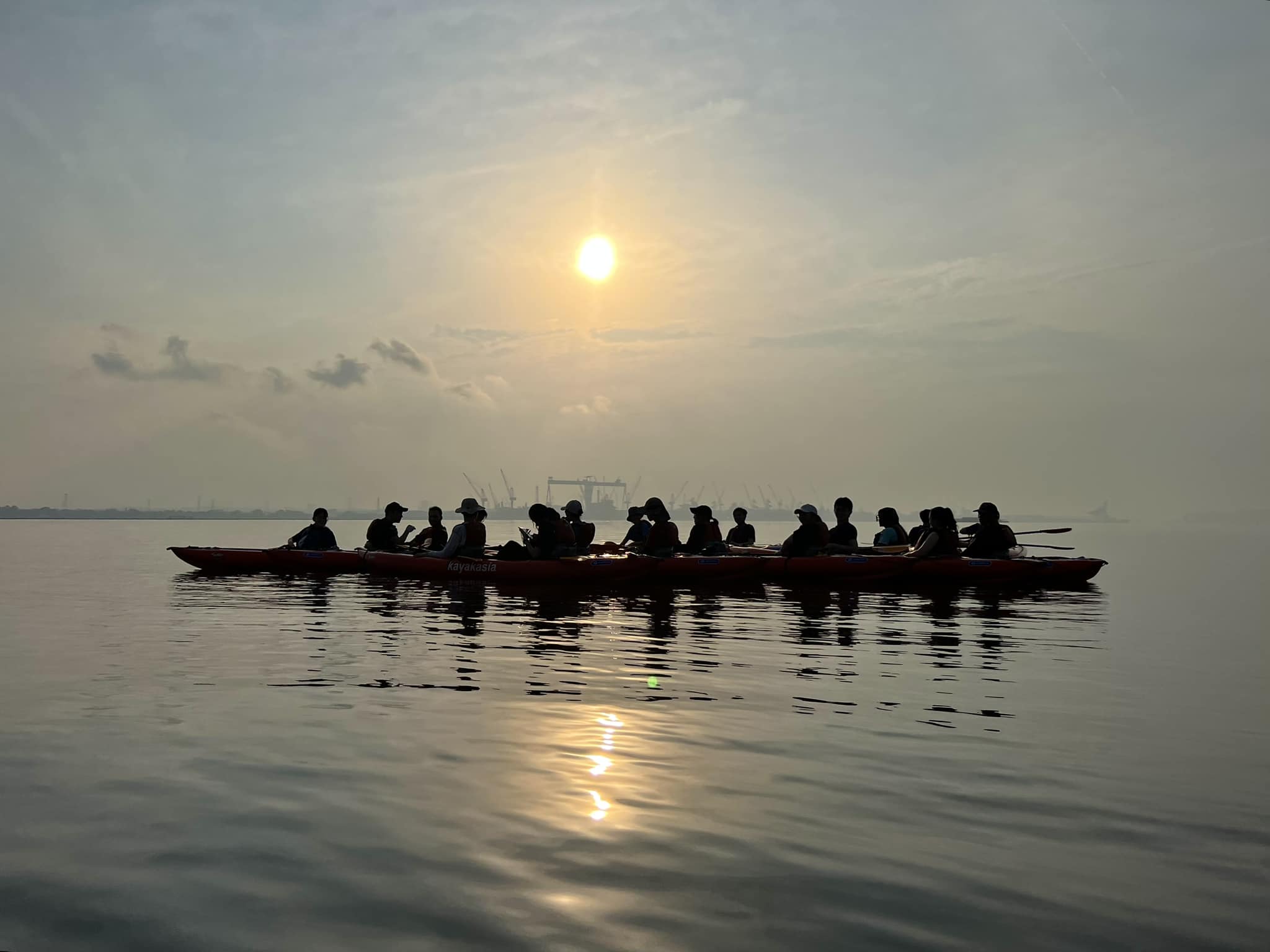 Kayakers in Sembawang. Photo from Kayakasia Facebook.
Kayakers in Sembawang. Photo from Kayakasia Facebook.
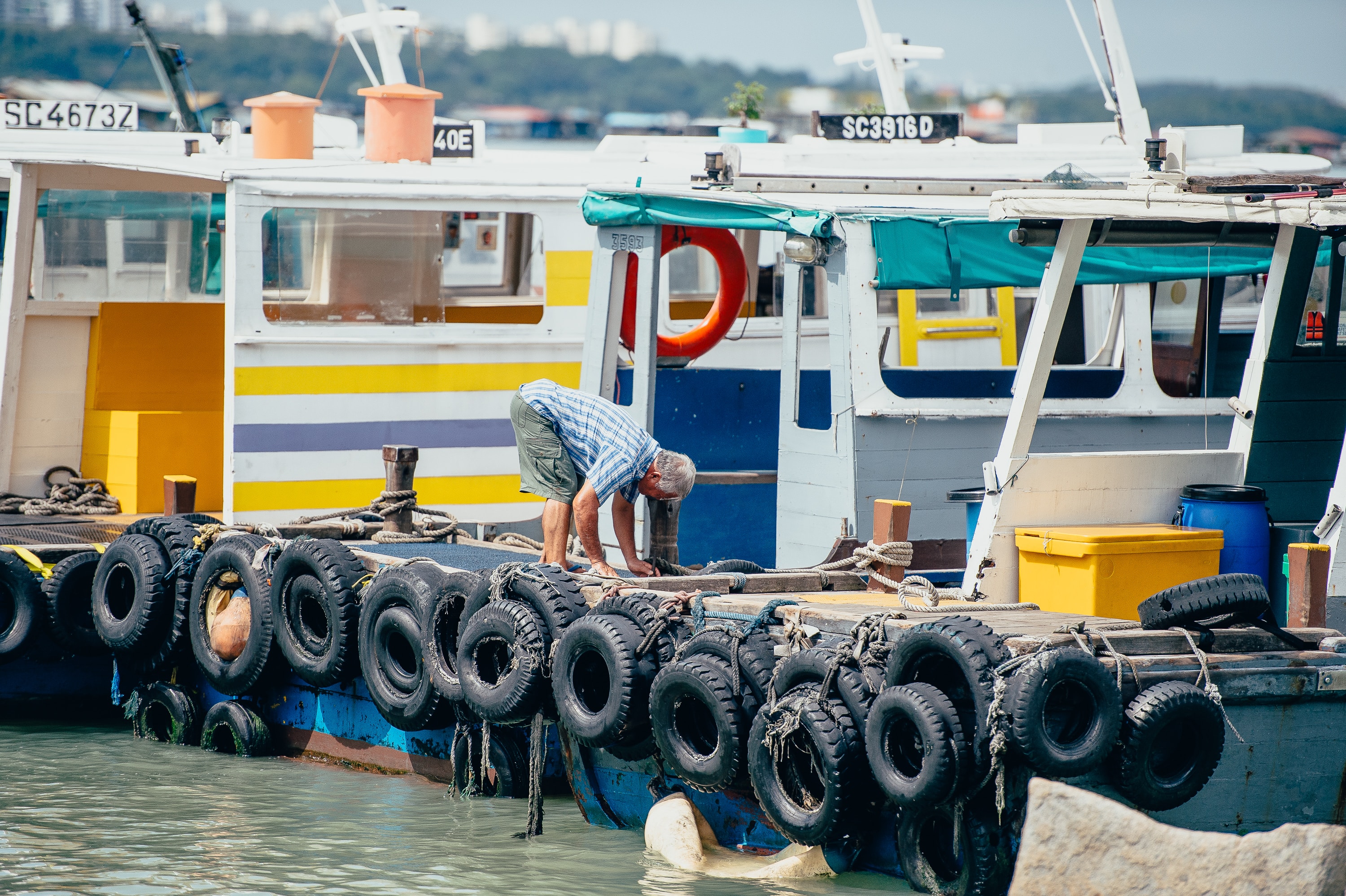 A boatman back from Pulau Ubin. Photo by Annie Spratt via Unsplash.
A boatman back from Pulau Ubin. Photo by Annie Spratt via Unsplash.
If we are willing to allow crocodiles to become re-established along other stretches of our coastline, it could mean putting an end to all fishing, swimming, and water sports activities in these areas, so as to reduce the chances of somebody getting bitten. Is the Singaporean public truly ready and willing to give up some of their favourite recreational spots, and let the crocodiles reclaim their place as rulers and guardians of the coast?
Coexistence could also mean installing fences and other barriers to prevent crocodiles from getting close to our public beaches. However, this means investing considerable time, money, manpower, and other resources into construction, constant inspections, and regular maintenance of these structures. It could entail unsightly infrastructure, akin to the huge fences erected along stretches of Pulau Ubin’s northern coastline to deter illegal immigrants. While these might exclude large crocodiles, small individuals could still pass through the gaps, not to mention the possible impacts on the movements of other large marine creatures such as sea turtles and dugongs.
Another form of coexistence could mean the need for constant surveillance and vigilance, installing countless cameras to watch the water, or hiring an army of spotters perpetually on the lookout and ready to raise the alarm the moment a crocodile surfaces near a public area. Once a crocodile is sighted, all water activities may be suspended for hours, even days, nobody gets into the water until the coast is clear and the crocodile is believed to have moved on.
The size of the crocodile also matters. A young crocodile is more likely to react defensively than in a predatory manner, or simply mistake a human in murky water for a fish or other typical small prey. A bite from a smaller crocodile could possibly sever fingers, even take off a hand or foot, but still leave the person alive with a traumatising story to recount. A large adult crocodile however, is capable of consuming an entire human body, and leaves practically nothing behind; even the bones can be digested by powerful stomach acids. Even if the victim survives, they are often left with gruesome injuries that require immediate surgery and critical care, a long, painful recovery process, expensive physiotherapy, and possibly a lifetime of PTSD.
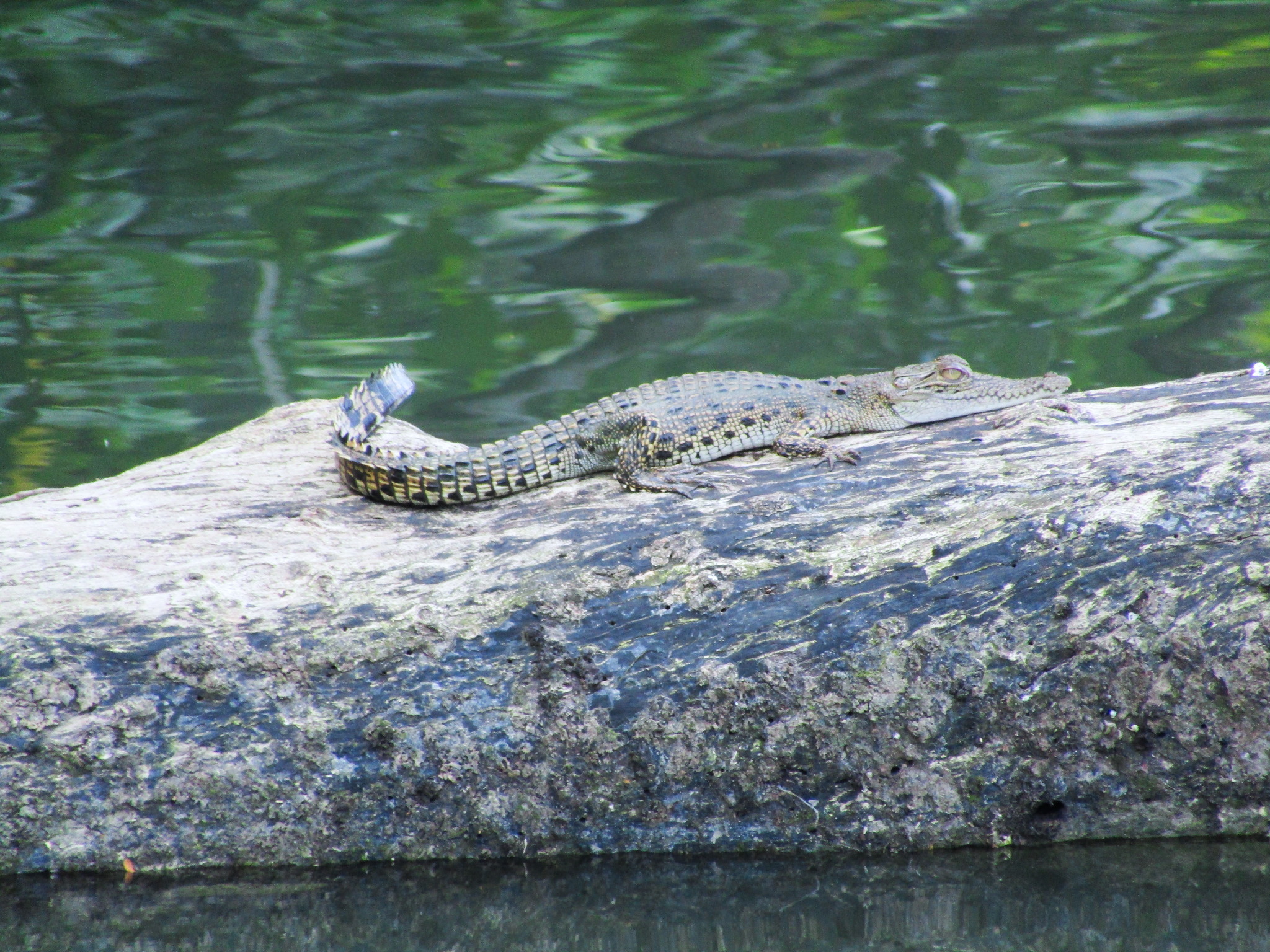 A very young Estuarine crocodile rests on a fallen tree. Every year, very small young crocodiles can be seen in some parts of Sungei Buloh, indicating that breeding is taking place. Despite being protected by their mother for some time, most will not survive, as they are vulnerable to all sorts of predators, including snakes, monitor lizards, birds, otters, large fishes, and even other crocodiles. Photo courtesy of Ivan Kwan.
A very young Estuarine crocodile rests on a fallen tree. Every year, very small young crocodiles can be seen in some parts of Sungei Buloh, indicating that breeding is taking place. Despite being protected by their mother for some time, most will not survive, as they are vulnerable to all sorts of predators, including snakes, monitor lizards, birds, otters, large fishes, and even other crocodiles. Photo courtesy of Ivan Kwan.
Technology could come in handy one day to promote coexistence between crocodiles and humans; the Australians are looking into the use of sonar and artificial intelligence (AI) to detect and identify swimming crocodiles, possibly triggering the system to make a loud noise that then repels the reptile. Or using environmental DNA (eDNA), analysing water samples to pick up trace amounts of DNA shed by crocodiles in an area in order to detect their presence or absence. But these methods are still very much in their infancy, and might not be viable on a large-scale basis.
If the public is truly willing to consider coexisting with crocodiles across larger areas of Singapore, a lot more will need to be done to prepare everyone.
In such a scenario, NParks will have to take on a lot of responsibility and will need considerably more resources than it currently has, simply to manage one out of the many different plant and animal species found in Singapore. The nature community in Singapore will also need to step up and educate the people on the important roles that crocodiles play in our wetland ecosystems, while also ensuring that the public genuinely feels that their questions and fears are being heard and addressed, and their safety is a priority.
We can implement all the safety measures we want, but the moment somebody gets bitten by the one species with the strongest bite force of any living creature measured to date, all the hard work could be so easily undone.
It’s easy for many of us to say that we’re willing to give up the water, or to make certain sacrifices so that the crocodiles can coexist with us. I can see the appeal in that.
 An Estuarine crocodile’s toothy grin. An Estuarine crocodile has an average of 66 teeth, which are continuously shed and regrow throughout its life. Adult Estuarine crocodiles have the highest bite force of any living animal measured to date, capable of snapping their jaws shut with close to 3,700 pounds per square inch (psi), or 16,460 newtons, of bite force. Photo courtesy of Ivan Kwan.
An Estuarine crocodile’s toothy grin. An Estuarine crocodile has an average of 66 teeth, which are continuously shed and regrow throughout its life. Adult Estuarine crocodiles have the highest bite force of any living animal measured to date, capable of snapping their jaws shut with close to 3,700 pounds per square inch (psi), or 16,460 newtons, of bite force. Photo courtesy of Ivan Kwan.
Hear from those who had close encounters with crocodiles
What’s been sorely missing in the conversation over coexistence with crocodiles in Singapore over the past few weeks are the voices of the people who have had close encounters of their own, or those who might be most severely affected, not just by possible attacks from crocodiles, but by any measures implemented in the interest of public safety.
Where are the voices of the fish farmers off Changi, the Pulau Ubin villagers catching mud crabs in the mangroves, the migrant workers casting their nets in waist-deep water off Sembawang? How do the kayak fishers at Pasir Ris, the wakeboarders at Punggol, and the stand-up paddlers at Sentosa feel about the prospects of sharing the waters with crocodiles, or the possibility of always being ready to get out of the water at a moment’s notice?
And besides NParks staff in Sungei Buloh, what about the other people who have already been working for years alongside crocodiles in northwestern Singapore? Just because very few people live in this area doesn’t mean that there’s nobody near the water. Someone needs to listen to the stories from the Kranji anglers and the fish farmers off Lim Chu Kang. Then there are public servants in other government agencies, such as the Coast Guard and PUB, who might have had their own crocodile encounters in the vicinity.
In the ongoing conversation over coexistence with crocodiles in Singapore, all these stakeholders deserve to have a say.
Think again
I believe that crocodiles have a place in Singapore, and I will always speak up for them and the many other species that are trying to live alongside us, but I am all too aware that many Singaporeans think coexistence is easy, but simply do not understand what it means to live with an apex predator.
Think you really know crocodiles, and the Singapore public is truly ready to give coexistence a try? Think again.
Top image courtesy of Ivan Kwan and from Heng Swee Keat/Facebook
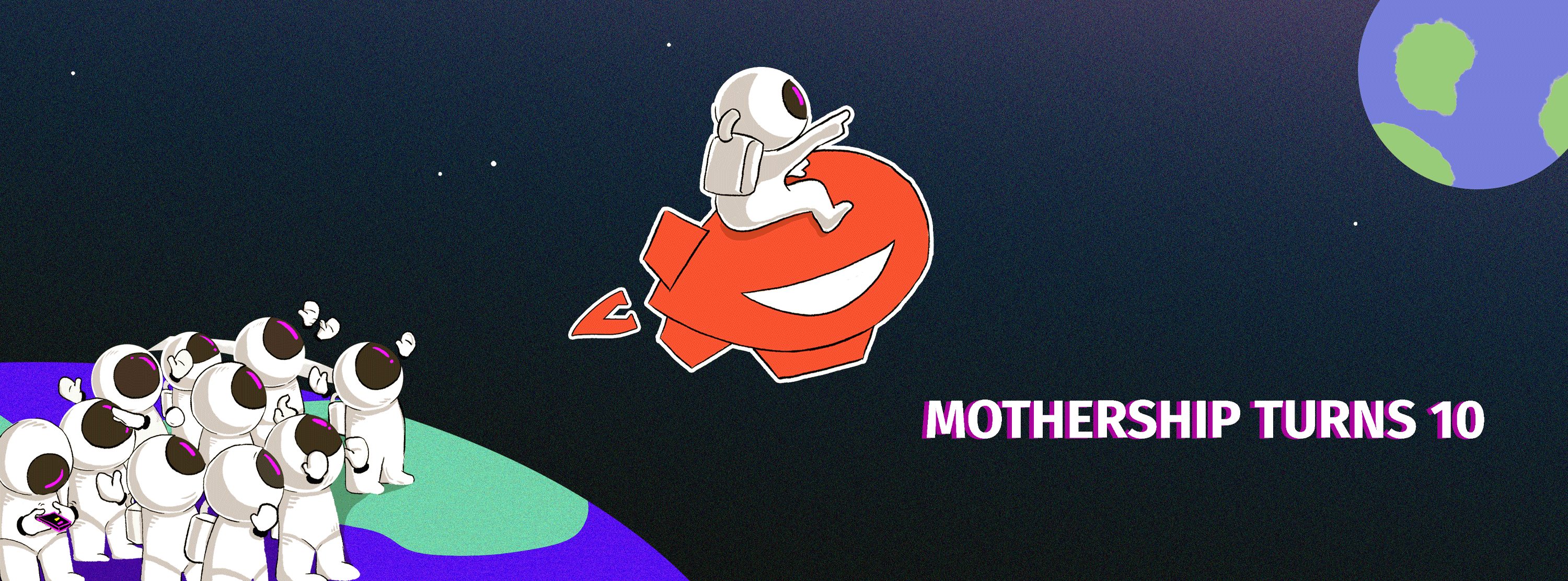
If you like what you read, follow us on Facebook, Instagram, Twitter and Telegram to get the latest updates.

